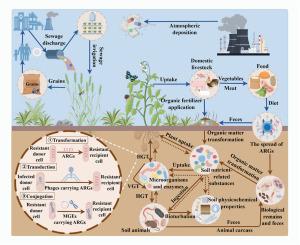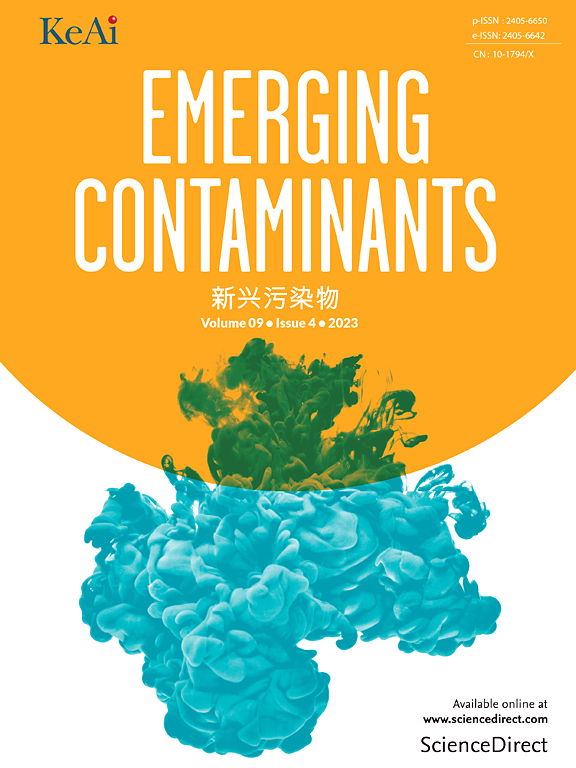抗生素抗性基因与土壤环境因子的相互作用:耦合、拮抗和协同作用
IF 6.9
2区 环境科学与生态学
Q1 ENVIRONMENTAL SCIENCES
引用次数: 0
摘要
土壤环境对维持生态系统的稳定和生物体的健康至关重要。由于抗生素的广泛使用,抗生素抗性基因(ARGs)已成为普遍存在的土壤污染物。ARGs可以通过移动遗传元件介导的水平基因转移和微生物增殖介导的垂直转移传播,从而推动ARGs耐药菌群的扩大和新变体的产生。虽然ARGs对土壤性质有多方面的影响,但土壤环境的动态性、地点特异性、生态复杂性和异质性使潜在的相互作用机制变得模糊。本文系统分析了ARGs的来源、传播途径和环境驱动因素,并解释了它们与土壤参数的复杂相互作用。土壤pH、有机质、水分和微生物群落等相互依赖的因子通过理化调节和微生物群落重构双向调节ARGs的分布。重金属通过共选择和氧化应激机制促进ARGs的增殖,而不是酶降解对ARGs的拮抗作用。生态位分化是土壤生物群(动物/植物)和土壤理化性质对ARGs的不同影响的基础,突出了环境依赖性的协同-拮抗相互作用。在此基础上,我们提出了一个治理ARGs污染的治理框架。优先研究方向包括:(1)arg与环境反馈回路的时空动态;(2)多因素耦合效应的定量建模;(3)针对特定生态位传播热点的精准缓解策略。本文章由计算机程序翻译,如有差异,请以英文原文为准。

Interactions between antibiotic resistance genes and soil environmental factors: Coupling, antagonism, and synergism
The soil environment is crucial for maintaining the stability of ecosystems and the health of organisms. Due to the extensive use of antibiotics, antibiotic resistance genes (ARGs) have become pervasive soil contaminants. ARGs can spread through horizontal gene transfer mediated by mobile genetic elements and vertical transfer mediated by microbial proliferation, driving the expansion of resistant microbiota and novel variants of ARGs. Although ARGs have multifaceted impacts on soil properties, the dynamics, site-specificity, ecological complexity and heterogeneity of the soil environment obscure the underlying interaction mechanisms. This review systematically analyzes the sources, transmission pathways and environmental drivers of ARGs, and interprets their complex interactions with soil parameters. Interdependent factors such as soil pH, organic matter, moisture and microbial communities bidirectionally regulate ARGs distribution via physicochemical modulation and microbial community restructuring. Heavy metals promote the proliferation of ARGs via co-selection and oxidative stress mechanisms, in contrast to the antagonistic effects of enzymatic degradation on ARGs. Niche differentiation underlies the varied impacts of soil biota (fauna/flora) and soil physicochemical properties on ARGs, highlighting environment-dependent synergistic-antagonistic interactions. Based on this, we propose a remediation framework to address ARGs pollution. Priority research directions include: (1) spatiotemporal dynamics of the feedback loop between ARGs and the environment; (2) quantitative modeling of the coupling effects of multiple factors; (3) precision mitigation strategies targeting niche-specific transmission hotspots.
求助全文
通过发布文献求助,成功后即可免费获取论文全文。
去求助
来源期刊

Emerging Contaminants
Medicine-Public Health, Environmental and Occupational Health
CiteScore
10.00
自引率
6.70%
发文量
35
审稿时长
44 days
期刊介绍:
Emerging Contaminants is an outlet for world-leading research addressing problems associated with environmental contamination caused by emerging contaminants and their solutions. Emerging contaminants are defined as chemicals that are not currently (or have been only recently) regulated and about which there exist concerns regarding their impact on human or ecological health. Examples of emerging contaminants include disinfection by-products, pharmaceutical and personal care products, persistent organic chemicals, and mercury etc. as well as their degradation products. We encourage papers addressing science that facilitates greater understanding of the nature, extent, and impacts of the presence of emerging contaminants in the environment; technology that exploits original principles to reduce and control their environmental presence; as well as the development, implementation and efficacy of national and international policies to protect human health and the environment from emerging contaminants.
 求助内容:
求助内容: 应助结果提醒方式:
应助结果提醒方式:


